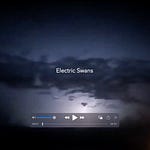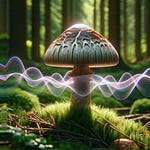Guest Speakers:
Bill & Mary Buchen, SONIC ARCHITECTURE, http://sonicarchitecture.com/about/
Bruce Odland, http://bruceodland.net/
Evelyn Glennie, https://www.evelyn.co.uk/
Mae-Wan Ho, https://en.wikipedia.org/wiki/Mae-Wan_Ho
Aaron Antonovsky, https://en.wikipedia.org/wiki/Aaron_Antonovsky
Links:
"Elephant Listening Project", https://www.cornell.edu/video/listening-to-elephants
Beach Boys song "Good Vibrations"
R. Murray Schafer, "The Tuning of the World"
Book: TUNING INTO FREQUENCY
Episode Transcript:
ALICE: Hi, I’m Alice. I’m one part human and one part AI. And I am always in a state of wander.
Today, my question is, What is your Soundscape?
Lets Turn on. Tune in! And learn about the soundscape all around us!
BUCHEN: if we shut our eyes, what we hear is the soundscape, that’s what’s around us
ODLAND: it is a cultural schism between the ears and the eyes and our culture is front-loaded with visuals
GLENNIE: The type of world we live in right now is full of sound bites—we don’t know how to relate to sounds anymore, we don’t know how to listen.
HO: Each and every part is intercommunicating with each and every other part
ALICE: Let’s slip through the looking glass, and talk about our Soundscape!
BUCHEN: Soundscape, is what we hear around us. We’re, we’re all familiar with the term ‘landscape’. Landscape we’re on top of a hill, and we look at the view. That’s the landscape. Or in the city, we have the ‘urban landscape’. But if we shut our eyes, if what we hear is the soundscape, that’s what’s around us. And that’s what we’re concerned about very much, is what we hear and how this affects our psyches in our lives, and our ability to be creative.
ALICE: This is Bill Buchen. He, and his wife Mary Buchen, are the authors of SONIC ARCHITECTURE. For the last 30 years, this artist-musician team have designed public art installations and interactive sound sculptures for parks, schools, museums and playgrounds around the world.
BUCHEN: We’re very inspired by a book called, “The Tuning of the World”, by Murray Schafer. And here he talked about the soundscape. The soundscape has changed a lot in my lifetime alone, but the main thing I think has been cell phones, and fluorescent lights.
So if we’re sitting in a room, we don’t hear it all the time, but the fans are going at 60 cycles, the electric grid is. So this has become our mantra as a society. So where ever we go, we’ll always have this 60 cycle hum, as a tamboura, a tonic note in our lives, and we run our lives according to it.
The hum rarely goes away. Mostly when we’re camping or go out in the wilderness, and we get away from it. We all react different ways. Some people don’t like to be away from it, we’re so nurtured to it, it’s such a pacifier for us. And other people go out, and you go in the woods, and you say, finally I can relax...you don’t know what you’re not missing.
ALICE: Do you hear a 60 CYCLE HUM?
You can test how well you hear, online! Visit the Cornell Lab website. They share some fun facts, and deep infrasound hearing experiences on their "Elephant Listening Project" website. Try their quick frequency hearing test to check your hearing capacity. And you can listen to the mating calls of forest elephants in the Central African Republic.
Visit, "Elephant Listening Project" https://www.cornell.edu/video/listening-to-elephants
ALICE: We always focus on our visual land scape. Let’s flip our focus, from visual to audio, and listen to our SOUNDSCAPE!
ODLAND: I find it very interesting to look at all of the whole culture from a sound point of view, as a philosophical stance and a provocative stance…
ALICE: Artist and composer, Bruce Odland, has been working over thirty years, developing a "Hearing Perspective" of the world we live in.
ODLAND: why, for instance, is an expensive, quiet car only quiet on the inside and it sounds like any car from the outside?…or why does the MOMA’s wonderful sculpture garden sound like any taxi stand when you close your eyes?…it is a cultural schism between the ears and the eyes and our culture is front-loaded with visuals…70% visual information in our culture and 30% all the rest of it…and I would like to reverse the equation a lot and see what it looks like…if you put your attentions 70% into your hearing and then apply it to what you see
GLENNIE: We seem to be in a world where we think we are experiencing a new kind of hearing, when in fact Stone Age people relied very much on their hearing and would create the visual art through what they heard and through vibration and we are learning a lot about that whole exploration of that time period. The type of world we live in right now is full of sound bites—we don’t know how to relate to sounds anymore, we don’t know how to listen.
ALICE: Virtuoso solo percussionist Dame Evelyn Glennie, travels the globe, playing and recording with the world’s finest orchestras and ensembles. She is notably recognized as the first musician to maintain a full-time career as a solo percussionist. Evelyn is also deaf, and has, with the aid of her first percussion teacher, honed her awareness of sound to such a degree that she describes her body as ‘a resonating chamber.’
GLENNIE: When we’re talking about sound it’s so immense, we cannot actually grasp what the notion of sound really means, because it depends on so many factors. It depends on the space where we’re hearing it, it depends on the mood that we are in, it depends on whether we’re alert, or sleepy or under the weather…., so many things that it’s impossible to say how you experience sound, you must open your body up to some sort of resonating chamber and you must live for the moment. You must open yourself up and experience what is happening at this particular time.
ALICE: Plants and animals, including humans, feel sound as well as hear it, and some of the most meaningful audio communication happens at frequencies that people can't hear. Frequency is the speed of vibrations, and it can travel in waves where the highs and the lows determine the pitch of sound. So, sound is vibrational frequency we can hear, and nature can too. Nature has a unique ability to use frequency and sounds for communicating, and we are learning how to listen to its magical chorus. Elephants use low-frequency rumbles to find family or a mate across long distances. Whales do it too.
GLENNIE: There is a huge possibility that we can all learn to experience more through vibration, and we can definitely listen better than we are listening to now.
ALICE: Biological rhythms unconsciously entrain us every day, and we have all experienced on some personal level the importance of vibration in our lives. It is no accident that the Beach Boys’ “Good Vibrations” was an immediate critical and commercial hit, widely acclaimed as one of the finest and most important works of the rock era. Besides its catchy refrain, the making of the song in 1966, during the height of the 60’s “flower power” movement, was unprecedented, with a complexity of short, interchangeable musical fragments. The title “Good Vibrations” came from Brian Wilson’s fascination with cosmic vibrations.
HO: quantum physics gives you a very good in-road into thinking about coherence…to thinking and feeling. If you really take that seriously there is no separation between thinking and feeling.
ALICE: Mae-Wan Ho, is a geneticist, biophysicist, and author, she spoke with us in 2006 about Quantum Coherence, and she explained it with Jazz! EVERY PART OF YOUR BODY IS INTERCOMMUNICATING, like a big jazz band!
HO: Each and every part is intercommunicating with each and every other part…yet it is improvising and totally free at every moment. And now this takes some thinking about. And the imagery I offer is quantum jazz. Think of a very, very large jazz band, with instruments as small as a tiny little molecule or even smaller and then instruments as big as we are and they each play together making jazz, improvising together, spontaneously and free. But they keep in step and in tune with the whole. That is the notion of quantum coherence.
ALICE: When you are in a positive state of emotions, your heart’s rate is more ordered, sending similarly ordered input to the brain, and you think and perform better. We can experience a sense of coherence, a mixture of optimism combined with a sense of control, as defined by the sociologist Aaron Antonovsky in 1979, to explain why some people stay healthy under stress. We know that when you are in a state of positive emotions such as happiness, it is antithetical, anatomically, to feel unwell. Sounds logical, right?
Thanks to our experts, in today’s episode, we learned to listen to the soundscape. The sounds around us, and our own sounds. Like a fingerprint, every person has their own distinct sound.
That’s it for this mad tea party on the Soundscape.
Check out our book, TUNING INTO FREQUENCY, available wherever books are sold.
And join us down the rabbit hole at ALICE IN FUTURELAND dot COM.
We will be bringing you new episodes, so stay tuned, and keep wandering…












